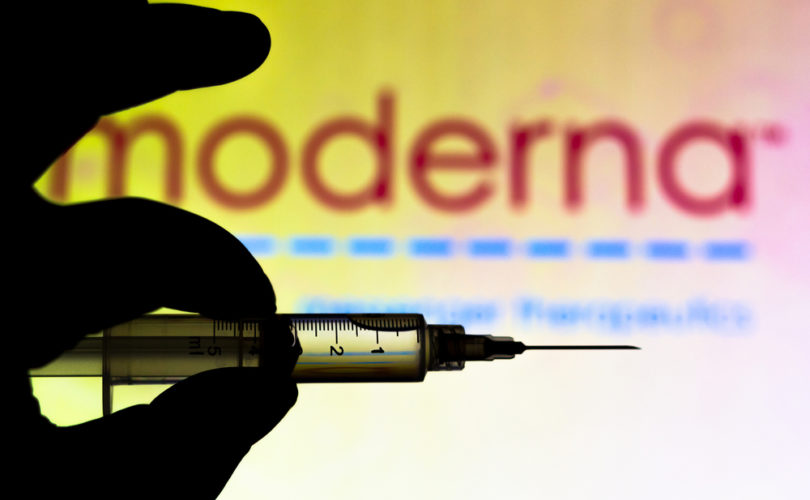LifeSiteNews has been permanently banned on YouTube. Click HERE to sign up to receive emails when we add to our video library.
March 26, 2021 (LifeSiteNews) — American biotechnology company Moderna, developer of one of the country’s two mRNA experimental vaccines for COVID-19, has announced plans to create a hybrid vaccine that will target both COVID and influenza, again using its new mRNA technology.
Moderna CEO Stéphane Bancel made the announcement during The Wall Street Journal’s Health Forum, where he said the efficacy of flu vaccines would be aided by being developed with mRNA technology and could be on the market in just a couple of years. The dual vaccine would be required to go through the Food and Drug Administration’s (FDA) standard approval procedures before being authorized for use, contrasting with the “emergency use authorization” granted to its mRNA COVID-19 jab in December 2020, a week after Pfizer had their equivalent shot approved.
Bancel suggested that the dual vaccine will help immunize people from both COVID and the flu. It would be necessary, he anticipated, to guard against both on an annual basis. The Moderna executive predicted that “more concerning mutations of the new coronavirus” will begin emerging over the next six months and that — both influenza and COVID-19 being respiratory-related illnesses — the vaccines might be packaged together quickly.
Moderna is reportedly working to overcome obstacles presented by the apparent mutation of the coronavirus, developing a modified version of their current mRNA therapy which will target more contagious forms of the virus and be useful against more than one strain at a time, the Wall Street Journal wrote. Additionally, the gene technology firm is reportedly developing five mRNA-based vaccines for different cancers.
Flu vaccines fluctuate in their effectiveness from one year to another, with some as low as 30 percent effective, up to a maximum of around 60 percent. According to the Centers for Disease Control and Prevention (CDC), flu vaccines created for the 2019–2020 season had a roughly 45 percent efficacy against the viral infection, meaning that recipients of the shot were still statistically more likely than not to contract the illness, despite their inoculation.
“Today the vaccines we have for seasonal flu are OK in a great year and they are pretty bad in a bad year, in terms of efficacy,” Bancel noted. “It is not impossible that in a couple of years we should have the product I just talked about — a high efficacy seasonal flu vaccine and a COVID vaccine –– for you at your pharmacy on an annual basis.”
Although headlines the world over touted both Moderna and Pfizer/BioNTech’s mRNA jabs as having an efficacy greater than 90 percent, and the CDC reported Moderna’s specifically as 94.1 percent effective in a laboratory trial setting, the data garnered from clinical trials admits of some important lacunae. This, in turn, could mean that Bancel’s optimism on the effectiveness of mRNA-developed flu vaccines is misplaced.
In medical parlance, “efficacy” is a term used to denote results obtained from controlled conditions, such as those found in clinical trials. “Effectiveness,” on the other hand, regarding vaccine use, refers to the results observed from real-world use, outside of the lab, after the vaccine has been rolled out.
With this in mind, the CDC’s 94.1 percent figure may not be what is achieved in widespread, real-world use. Notably, the trials for Moderna’s COVID shot tested only for the virus on those who expressed symptoms, leaving asymptomatic trial participants uncounted, thus rendering the overall “effectiveness” of the vaccine unknowable.
Not only is there doubt over the effectiveness of the jab to combat the spread of COVID-19, but questions still remain about the necessity thereof.
As early as November 2020, Dr. Mike Yeadon, the former Vice President and Chief Scientist at Pfizer (which also manufactures an mRNA COVID shot), flatly rejected any need to vaccinate the population against COVID-19.
Writing for Britain’s Lockdown Sceptics, Yeadon said there was “absolutely no need for vaccines to extinguish the pandemic … you do not vaccinate people who aren’t at risk from a disease.” “You also don’t set about planning to vaccinate millions of fit and healthy people with a vaccine that hasn’t been extensively tested on humans,” he said.
In fact, mounting evidence suggests that Moderna’s mRNA therapy is responsible for seriously injuring vast numbers of people who have taken the jab in the hope of avoiding illness from COVID-19. The CDC’s Vaccine Adverse Event Reporting System (VAERS), which collates self-assessed reports from individuals who record side-effects after getting a vaccine, displays some 16,749 reports of injury following use of Moderna’s vaccine.
The latest data on the system, taken from December 14, 2020, up to March 11, 2021, shows 834 deaths have been recorded, accounting for almost 5 percent of total reports. A further 338 recordings of serious disabilities were submitted after taking the Moderna jab and 1,890 hospitalizations.
LifeSiteNews has produced an extensive COVID-19 vaccines resources page. View it here.

